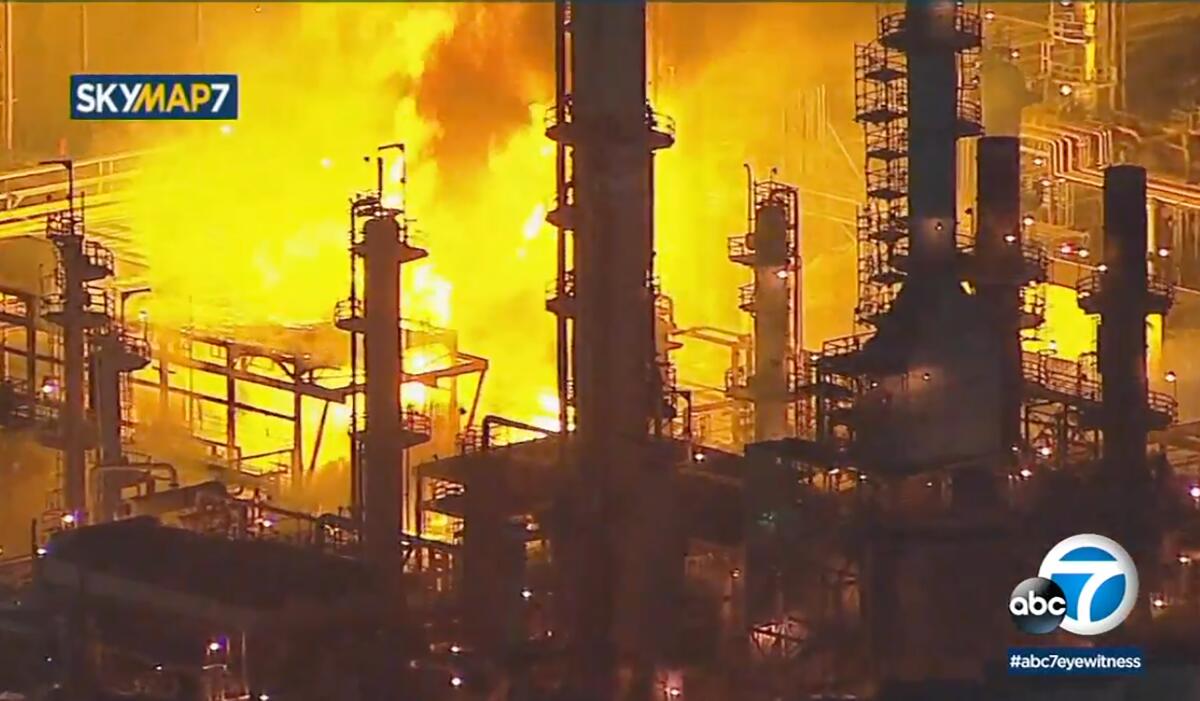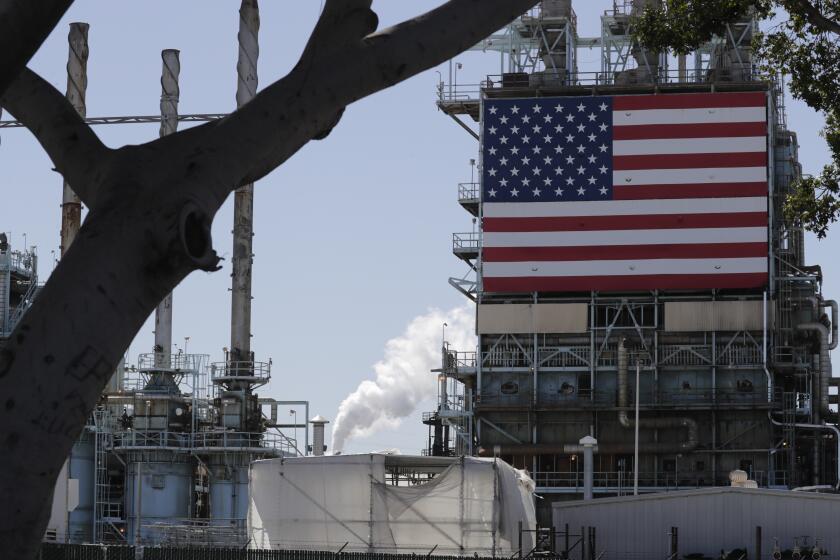Fire exploded from part of Carson refinery recently cited for workplace safety issues

- Share via
The fire that broke out Tuesday at the West Coast’s largest oil refinery — Marathon Petroleum in Carson — was sparked in a section of the plant that California inspectors recently cited for workplace safety violations, Cal/OSHA officials confirmed Thursday.
The late-night explosion occurred in a unit where gasoline is produced, known as the No. 2 reformer. That’s the same part of the refinery that was cited in November by the California Division of Occupational Safety and Health for four violations after a July inspection, according to both Cal/OSHA and Dave Campbell, secretary-treasurer for the United Steelworkers Local 675, which represents nearly all the refineries in the South Bay.
No one was reported injured in Tuesday’s fire, but it has resurrected community concerns about the region’s seven oil refineries and their history of accidents, explosions and releases of toxic pollution.
Neighbors and community activists protested when the South Coast Air Quality Management District in 2017 approved a merger of the Carson and Wilmington refineries, then operated by Tesoro (later Andeavor), creating the West Coast’s largest refinery.
“They said it was going to be a safer project, a cleaner operation, but they haven’t shown us the refinery has been safer at all,” said Alicia Rivera, a Wilmington organizer with Communities for a Better Environment, a group that sued to challenge the merger.
Cal/OSHA inspectors visited the refinery in July, ultimately citing Tesoro/Marathon for four workplace safety violations. These included findings that the company failed to “provide training to its unit operators” before rolling out new maintenance procedures, did not obtain signatures from employees indicating they’d been trained, and did not allow the maintenance crew the ability to review and approve any of the changes.
Cal/OSHA fined the company $3,000, $750 for each violation. In December, the company contested the charges, according to Frank Polizzi, spokesman for the state occupational health agency. A prehearing conference is scheduled for May 26.
Marathon did not respond to questions about where that process stands, other than to say it is continuing. The company, after its merger with Andeavor, became the largest U.S. petroleum refinery operator, with 16 refineries and a refining capacity of more than 3 million barrels a day.
Local air regulators late Thursday released the results of air quality samples taken from two locations next to the refinery in the early-morning hours after the fire broke out. The samples were analyzed for toxic air pollutants including benzene, toluene, styrene and tetrachloroethylene and “did not show any levels above what is normal in ambient air in the South Coast Air Basin,” according to the South Coast Air Quality Management District.
The air district also deployed a mobile air monitor to measure particulate matter and found levels “within typical range for urban areas.” The agency said it “continues to evaluate whether any regulatory violations occurred as a result of the incident.”
More than 180,000 people live within three miles of the Carson refinery, according to the U.S. Environmental Protection Agency. Both regulatory records and neighbors say the refinery has a record of wafting noxious emissions into surrounding areas.
The air district has previously cited the refinery with at least 13 violation notices since June 2018, records show. The alleged violations include vapor leaks, creating a public nuisance by discharging air contaminants and a failure to comply with rules to minimize flaring, the burn-off of excess gas that sends pollution into the air.
Rivera said residents frequently report incidents at the refinery to the air district but rarely find out what happened.
“That’s the usual pattern: We report flaring, we report smoke, then they send an inspector and nothing really comes of it,” Rivera said. Most of the time, she said, “we just don’t hear anything else, and the worst is that they tell us the investigation is pending.”
Authorities are unsure what caused the explosion, and are investigating complaints from nearby residents that noxious gases wafted into their neighborhoods.
Five years ago an explosion rocked the Torrance Refinery — so powerful it registered the equivalent of a magnitude 1.7 earthquake — spewing smoke and dust over surrounding communities. The February 2015 blast sent a 40-ton piece of equipment close to crashing into a tank containing hydrofluoric acid, a dangerous chemical that can form a deadly, ground-hugging cloud.
Campbell, the union representative, said Tuesday’s incident happened after the company cut back the number of employees working at the reformer over the last month or so. Each crew was reduced from five workers to four, he said.
Each crew comprises a console operator — who oversees the operation during a given shift, mostly relying on electronic indicators to monitor pressure and open and close valves — and “field” crew members, who are the eyes and ears of the operation.
“They’re the outside operators,” Campbell said. “They pull samples, make sure that pumps and compressors have proper lubrication, that there are no leaks — they are always looking for leaks — and they’re listening for odd noises.”
Campbell said that when the company cut back on the crew size, the union flagged the state safety inspectors.
“I can’t say that’s the reason why it happened,” he said. “But, yes, it is the only place where crew size was cut.”
At the moment, Cal/OSHA appears to be the only outside agency investigating the circumstances that led to Tuesday’s explosion.
Austin Bennett, a spokesman for the Los Angeles County Fire Department, said county personnel are not involved in investigating the fire’s cause and didn’t enter the refinery after the blaze erupted.
Bennett said that’s not atypical, because many refineries have their own teams that respond to emergencies — including fires.
“They didn’t want us to enter the refinery at any point,” he said. The incident, he added, was eventually “turned over to the refinery for overhaul and determination.”









